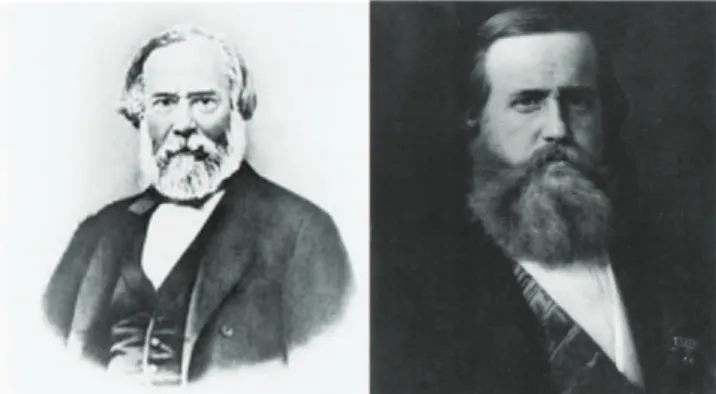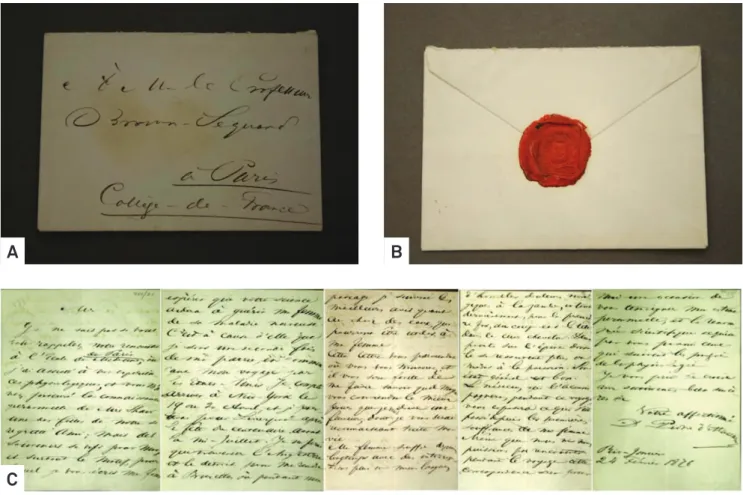633
HISTORICAL NOTES
Letters from Dom Pedro II to professor
Brown-Séquard: imperial correspondence
and neurophysiology
Cartas de Dom Pedro II para o professor Brown-Séquard:
correspondência imperial e neurofisiologia
Hélio A. G. Teive1, Francisco M. B. Germiniani1, Renato P. Munhoz1, Andrew J. Lees2
he distancing of Neurology from both Internal Medicine and Psychiatry had its roots back to the second half of the 19th
century. Professor Jean-Martin Charcot’s systematic study of dis-eases of the nervous system at La Salpêtriére, in Paris, formed the irst Neurology school1. Charles-Édouard Brown-Séquard, a
Mauritian born in 1817, therefore a British citizen, had already conducted some important neurophysiological experiments in Paris and, in 1860, was appointed as the irst physician at the National Hospital for Paralytic and Epileptic at Queen Square, in London. Both pioneer neurologists were respected physicians with large private practices. Amongst their many celebrated pa-tients were some of Europe’s aristocracy, including the Emperor of Brazil, Dom Pedro II2-4.
Dom Pedro II and Brown-Séquard shared both a friend-ship and a doctor-patient relationfriend-ship. In this article, we have briely presented some extracts from the correspondence shared between Dom Pedro II and Professor Brown-Séquard,
highlighting some of the main topics and making a quick his-torical account of their shared events5.
PROFESSOR BROWN-SÉQUARD
Charles-Édouard Séquard, or simply Brown-Séquard (Fig 1) as he is better known, was born in Port Louis, Mauritius, in April, the 08th, in 1817, and died a few days
be-fore his 77th birthday, on April 02nd 1894, in Paris. His father
was an American sailor and his mother a local Creole. He studied Medicine in Paris, and graduated in 18462,6.
He came to be recognized worldwide as a brilliant neu-roscientist, whose area of expertise was the nervous system physiology, and he was eventually rewarded for his endeav-ors by his nomination to be the Professor of Experimental Medicine in 1878 in Paris, replacing Claude Bernard.
1Neurology Service, Internal Medicine Department, Hospital de Clínicas, Federal University of Paraná, Curitiba PR, Brazil; 2Reta Lila Weston Institute of Neurological Studies, UCL Institute of Neurology, London, United Kingdom.
Correspondence: Hélio A. G. Teive; Rua General Carneiro 1.103/102; 80060-150 Curitiba PR - Brasil; E-mail: hagteive@mps.com.br
Conflict of interest: There is no conflict of interest to declare.
Received 18 March 2012; Received in final form 28 March 2012; Accepted 04 April 2012 ABSTRACT
The authors have analyzed the content of a selection of letters written by Dom Pedro II, the Emperor of Brazil, and sent to Doctor Charles Brown-Séquard, the famous neurologist, between 1876 and 1885. The content of those letters focuses mainly on his wife’s, Princess Thereza Cristina, health issues and Dom Pedro’s personal desire to foster the research into the physiological study of the nervous system.
Key words: Brown-Séquard, Dom Pedro II, emperor of Brazil.
RESUMO
Os autores analisaram o conteúdo de cartas selecionadas escritas por Dom Pedro II, o Imperador do Brasil, entre 1876 e 1885, e dirigidas ao Doutor Brown-Séquard, um famoso neurofisiologista. O conteúdo das cartas versa principalmente sobre os problemas de saúde da esposa do Imperador, a Princesa Thereza Cristina, bem como sobre seu interesse em fomentar a pesquisa no estudo fisiológico do sistema nervoso.
634 Arq Neuropsiquiatr 2012;70(8):633-636
Brown-Séquard was cyclothymic, with bouts of exuberance, grandiosity, excessive nervous energy alternating with peri-ods of profound depression and apathy. his may in part ex-plain his erratic career path in which he oscillated between laboratory research and private practice, in Paris, London, Boston, and Richmond, in Virginia2,6,7.
Among his major works is the description of the physical signs linked with spinal hemisection, better known as Brown-Séquard’s syndrome, as well as other articles on the physiol-ogy of nerves, vasomotor relexes, an experimental model of epilepsy and his most popular work – although highly con-troversial – the hormone replacement therapy. his interna-tional fame led to reach patients who traveled from all over Europe to visit him in his consulting suite. he list of his fa-mous patients included Louis Agassiz, Professor of Zoology and Geology at Harvard College, American Senator Charles Summer and the Emperor of Brazil, Dom Pedro II2,6.
DOM PEDRO II – EMPEROR OF BRAZIL
Brazilian Monarchy began with the arrival of the Portuguese Royal Family in Brazil, after they had led Portugal, with the aid of the British Royal Navy, in order to avoid the advancing troops of Napoleon Bonaparte. he Regent Prince of Portugal, Dom João, and his wife, Infanta Carlota Joaquina, settled in Brazil, and their son Pedro de Alcântara (Dom Pedro I) became the irst Emperor of Brazil, who was mar-ried to Maria Leopoldina, archduchess of Austria. heir son, Pedro d’Alcântara, also known as Dom Pedro II, was born on December 02nd, in 1825, in Rio de Janeiro. In 1848, at the age
of 23, he became Emperor of Brazil (Fig 1). His reign contin-ued uninterrupted until 1889, when the royal family was ban-ished following the proclamation of the Brazilian Republic. Dom Pedro II married Princess Teresa Cristina de Bourbon, with whom he had two daughters, the most famous being Princess Isabel, and two sons, both of whom died at two years of age8,9.
During his reign, Dom Pedro II made three grand voy-ages: to Europe, to North America, and to the Orient. A
consummate reader and polyglot, he devoted himself to the arts and fostering of science. He had little interest in politics, which may have contributed to some of the ofensive nick-names he was forced to bear (“Pedro Banana” – “Banana Peter”; “Pedro da Mala” – “Suitcase Peter”)8,9.
Dom Pedro experienced profound fatigue, asthenia and malaise, and sought the opinion of a number of European doc-tors, however he was always traveling in the company of his private physician, doctor Motta Maia. He consulted Charcot, in Paris in 1887, who diagnosed him as sufering from sur-menage psycho-physique (neurasthenia), diabetes mellitus
and probably a related peripheral neuropathy. His death cer-tiicate was signed by Professors Bouchard, Motta-Maia, and Charcot, on December 5th, in 1891, at the Bedford Hotel, in
Paris, with the cause of death recorded as pneumonia8-10.
THE CORRESPONDENCE BETWEEN DOM PEDRO II AND BROWN-SÉQUARD
Between 1876 and 1885, Dom Pedro II corresponded with Brown-Séquard, and ten of their letters were analyzed for the present article (Fig 2). he main topics covered in the cor-respondence are summarized in Table. Some were related to the health of the Emperor’s wife, Princess Teresa Cristina, who sufered from recurring pain in her lower limbs, possi-bly neuropathic in origin, as well as spondylotic pain in the dorsal and lumbar segments. When the princess was irst in-troduced to the emperor, she had already a painful leg and walked with a limp that may have predisposed her later to have a degeneration of the thoracic and lumbar spine5.
he letter written by Dom Pedro II, from February 24th,
1876, stated: “Ma femme soufre depuis longtemps avec des in-terruptions plus ou mois longues d’horribles douleurs nevral-giques à la jambe, et tous dernièrement, pour la première fois, du corps et à la tête, dans le cuir chevelu. Deux points sur l´épine dorsale se ressentent plus ou moins à la pression. Son état général est bon.”5
Later, in the letter of June 29th, 1876, while the Emperor
was in Philadelphia, he wrote to Brown-Séquard about his visit to Professor Charcot: “Je veux y consulter aussi le Dr. Charcot et c´est bon que vous deux puissent s´entendre aux même temps avec mon médicin qui a soigné ma femme, et vous donnera tous les renseigments nécessaires.”5
In other letters, Dom Pedro II mentions lectures given by Brown-Séquard that he had attended in person, as well as his own interest in neurophysiology and science. He also enquires whether Brazilian physicians could come as visiting physicians to Paris. Finally, in a sympathetic gesture of friend-ship he wrote a letter in 1883 about the two vacancies left at the Academy of Medicine of Paris, one following the death of Professor Claude Bernard: “Il y a à present deux places va-cantes à l´Académie. Quand vous fera-t-on justice?”5.
635
Hélio A
. G.
Teiv
e e
t al
.
L
ett
er
s Dom P
edr
o II v
er
sus Br
own-Séquar
d
Table. Letters from Dom Pedro II to Brown-Séquard.
Themes Letters in chronological order
Rio de Janeiro (February 24th,
1876)
Philadelphia (June 26th,
1876)
Rio de Janeiro (April 13th,
1879)
Rio de Janeiro (April 11th,
1880)
Rio de Janeiro (September 08th, 1880)
Rio de Janeiro (August 29th,
1887)
Rio de Janeiro (October 09th ,
1882)
Rio de Janeiro (December
14th, 1882)
Rio de Janeiro (April 07th,
1883)
Rio de Janeiro (September
23rd , 1884)
Rio de Janeiro (September 06th , 1885)
Attending/receiving news of Brown-Séquard’s physiology classes and/or studies
X X X X X X X X X
The empress health issues X X X
sojourn in Boston X X X
Trip from England to
Brussels X X X
Progresses in Physiology X X X
Progresses in Science X X X
Mentioning Charcot X
Accompanying physician X X
Mentioning Charles
Bernard X
Visiting Brazilian
physicians in Paris X X X
Invitation to come to Brazil X X X X X X X
Exchanging personal
636 Arq Neuropsiquiatr 2012;70(8):633-636
1. Goetz CG, Bonduelle M, Gelfand T. Charcot: constructing Neurology. Oxford, UK: Oxford University Press; 1995.
2. Aminoff MJ. Brown-Séquard. An improbable genius who transformed medicine. Oxford, UK: Oxford University Press; 2011.
3. Teive HAG, Almeida SM, Arruda WO, Sá DS, Werneck LC. Charcot and Brazil. Arq Neuropsiquiatr 2001;59:295-299.
4. Goetz CG. Battle of the titans. Charcot and Brown-Séquard on
cerebral localization. Neurology 2000;54:1840-1847.
5. Letters from Dom Pedro II to Brown-Séquard. London, UK: Archives of the Royal College of Physicians; 2011.
6. Rengachary SS, Colen C, Guthikonda M. Charles-Édouard
Brown-Séquard: an eccentric genius. Neurosurgery 2008;62:954-964.
7. Goetz CG, Aminoff MJ. The Brown-Séquard and S. Weir Mitchell
Letters. Neurology 2001;57:2100-2104.
8. Schwarcz LM. As barbas do imperador. Dom Pedro II, um monarca nos trópicos. São Paulo: Companhia das Letras; 1998.
9. Calmon P. História de Dom Pedro II. Rio de Janeiro: Livraria José Olímpio Editora/MEC; 1975.
10. Gomes MM. The decline of Dom Pedro II’s Empire and health.
Neuropathogenic implications. Arq Neuropsiquiatr 2007;65:1260-1265. References
CONCLUSIONS
Dom Pedro II, the Emperor of Brazil, was an intellectual attracted to arts and sciences. hese interests may help to explain the genuine friendships he forged with some of his physicians, including Charcot and Brown-Séquard, and his sincere desire to encourage the best Brazilian physicians to travel to France to enhance their education.
ACKNOWLEDGMENTS
he authors thank Professor and Doctor Clotilde de L. B. Germiniani for proofreading. We would also like to com-ment that although the given name of Dom Pedro II’s wife was Princess Teresa Cristina, her name is sometimes spelled as heresa Christina and hereza Christina in some documents in English or in Portuguese from Portugal (such as the Collecção D. hereza Christina Maria from the Biblioteca Nacional – http:// bndigital.bn.br/200anis/therezChristina.html. We chose to keep the more traditional Brazilian spelling of her name.
Fig 2. Example of the correspondence sent by Dom Pedro II to Professor Brown-Séquard. (A) Shows the front of the envelope of one of the letters addressed to Professor Brown-Séquard, at the Collège de France, in Paris. (B) The back of the envelope with the Brazilian imperial seal is showed. (C) The first letter written by Dom Pedro II to Professor Brown-Séquard is seen in its entirety.

